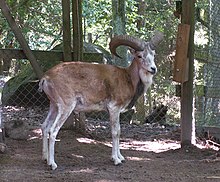Urial

As Uriale or steppe sheep ( Ovis vignei group) several are species of wild sheep summarized that in the western Central Asia are located.
distribution and habitat
You can find urials from northeastern Iran and western Kazakhstan to Balochistan and Ladakh . To the east of the distribution area live the larger Argalis and in the southwest the area borders on that of the mouflon . In a transition area in Northern Iran, urials and mouflons cross under natural conditions. In Ladakh, where the distribution areas of the Araglis and Uriale meet, some Argalis live in the immediate vicinity of the Ladakh Urial. Here, however, the Argalis prefer higher areas. Many urials live in fairly dry regions and some even penetrate into desert areas. They can almost always be found in mountainous terrain, but avoid very steep cliffs.
Appearance
Urials do not reach the size of the Argalis with 80 to 90 cm shoulder height and 35 to 90 kg body weight. The horns of the bucks also do not reach the dimensions of their eastern neighbors. Instead, the urials have a distinctive, stately neck mane, which is black or white depending on the subspecies. The basic color is light brown with a white underside. Some subspecies have a white saddle mark.
Duration
Trophy hunting and competition with domestic cattle are threatening the Urial population everywhere. In their open habitats, the animals are often not too difficult to kill, although they are generally considered shy. All subspecies of the urial are declining and today there are probably no more than 40,000 urials worldwide.
Way of life
Usually the old bucks live separately from the herds of the females. During the rut, which begins in late autumn or early winter, the herds break up into small groups of 3–4 females, which are defended by a strong buck.
species
In 2005 Peter Grubb distinguished three subspecies of the Urial. A 2011 revision of the hornbeams, carried out by Grubb and his colleague Colin Peter Groves , recognized five distinct species:
- Oman wild sheep ( Ovis arabica Sopin & Harrison , 1986); Oman ; originally described as a representative of the Argalis , the animals are more similar to the urials; due to a lack of data, the risk is unclear
- Tajikistan wild sheep or Bukhara urial ( Ovis bochariensis Nasonov , 1914); Tajikistan, Turkmenistan and Uzbekistan, north of the Amu Darya and Pyanj rivers ; In the 1990s there were probably still around 1,200 animals, the numbers are falling
- Afghan Urial sheep or Turkmenistan wild sheep or circular horn sheep ( Ovis cycloceros Hutton , 1842); Uzbekistan , Tajikistan , Turkmenistan , eastern Iran , Afghanistan , northern Pakistan , Kashmir , Punjab and Balochistan ; endangered. Reserves in which this species is protected include the Kirthar National Park and the Hingol National Park in Pakistan. This also includes the arcal or trans-Caspian urial ( Ovis cycloceros arkal Eversmann, 1850 ) as an independent subspecies that occurs on the Ustyurt plateau (Turkmenistan, Uzbekistan, northern Iran) and in western Kazakhstan and whose population is endangered with fewer than 11,000 animals , 1500 of them live in Golestan National Park in Northern Iran. In southern Turkmenistan on the border with Afghanistan and Iran, Arkal and Kreishornschaf flow into one another. However, the former seem to occur more in the west and the latter in the east, for example in the Badkhyz nature reserve .
- Punjab wild sheep or Punjab urial ( Ovis punjabiensis Lydekker , 1913); Punjab in Norpakistan between the Indus and Jhelam rivers
- Ladakh wild sheep ( Ovis vignei Blyth , 1841); Ladakh in northern Pakistan and India, distribution area only incoherently; old bucks are copper-red in summer with a white saddle mark and black mane, the underside white; endangered, around 2100 animals. The species is, for example, in the northern Indian Hemis National Park ago
Originally, the urials were all considered a subspecies of the Armenian wild sheep ( Ovis gmelini ), which belongs to the mouflon group. The original species allocation of the Armenian wild sheep was Ovis orientalis , introduced by Johann Friedrich Gmelin in 1774. Because of this, the eastern group of wild sheep was often referred to as the Ovis orientalis vignei group. The determination of Ovis orientalis goes back to a hybrid group in the Elburs Mountains , which means that the scientific name Ovis orientalis is not available.
literature
- Colin Peter Groves, Peter Grubb: Ungulate Taxonomy. Johns Hopkins University Press, 2011, ISBN 978-1-4214-0093-8 , pp. 1–317 (SS 235–238)
- Colin Peter Groves, David M. Leslie Jr .: Family Bovidae (Hollow-horned Ruminants). In: Don E. Wilson, Russell A. Mittermeier (eds.): Handbook of the Mammals of the World. Volume 2: Hooved Mammals. Lynx Edicions, Barcelona 2011, ISBN 978-84-96553-77-4 , pp. 727-739.
- RM Nowak: Walker's Mammals of the World. 6th edition. The Johns Hopkins University Press, Baltimore / London 1999.
- SH Prater: The Book of Indian Animals. Oxford University Press, 1971.
- V. Menon: A Field Guide to Indian Mammals. Dorling Kindersley , India 2003
- CITES instruction for the border veterinary service
Individual evidence
- ^ Peter Grubb: Order Perissodactyla . In: Don E. Wilson, DeeAnn M. Reeder (Eds.): Mammal Species of the World . A Taxonomic and Geographic Reference . 3. Edition. Johns Hopkins University Press, Baltimore 2005, ISBN 0-8018-8221-4 , pp. 637-722 (pp. 708-710).
- ^ A b Colin P. Groves, David M. Leslie Jr .: Family Bovidae (Hollow-horned Ruminants). In: Don E. Wilson, Russell A. Mittermeier (eds.): Handbook of the Mammals of the World. Volume 2: Hooved Mammals. Lynx Edicions, Barcelona 2011, ISBN 978-84-96553-77-4 , pp. 727-739.
- ↑ Colin Groves, Peter Grubb: Ungulate Taxonomy. Johns Hopkins University Press, 2011, 1-317 (SS 235-238).
Web links
- Photo of a Trans-Caspian Urial or Arkal ( O. v. Arkal )
- Extensive information about the types of urials ( Memento from June 22, 2003 in the Internet Archive )



